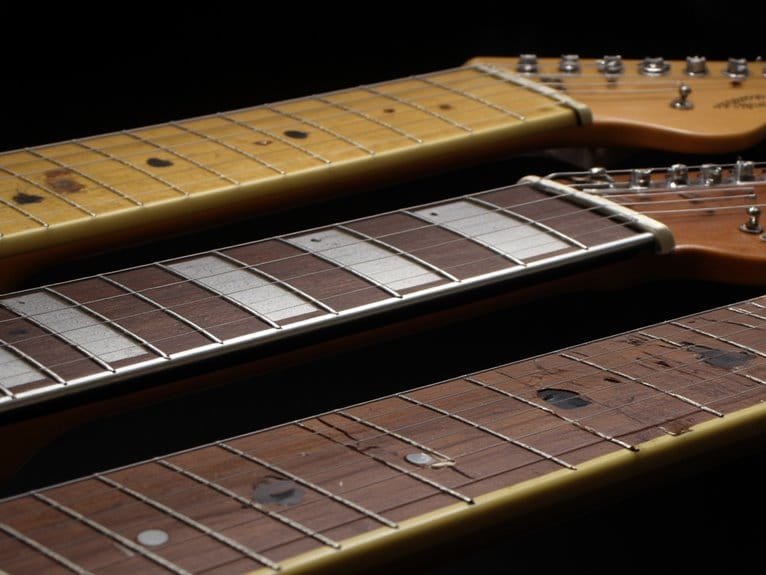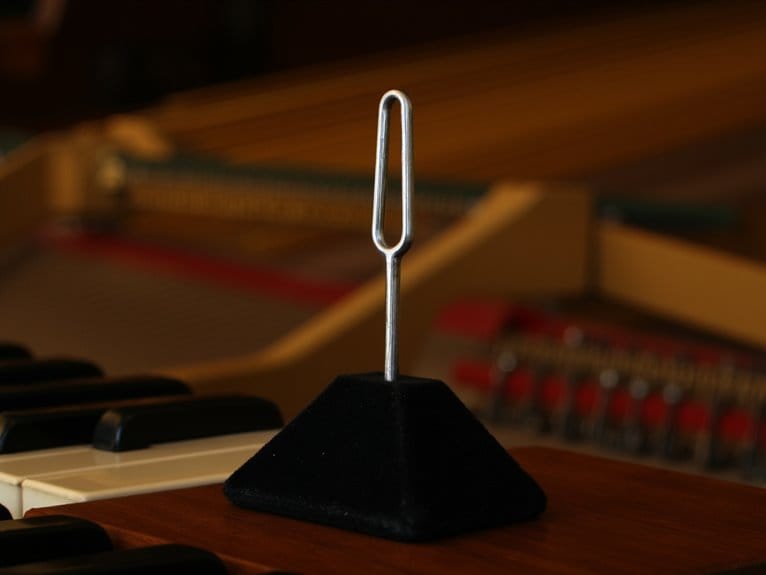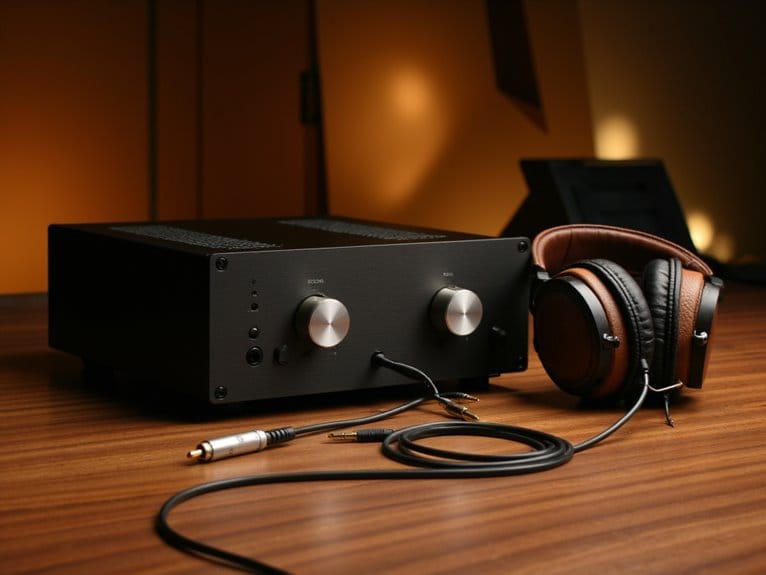Guitar Fret Materials: Nickel Vs Stainless Steel Vs Brass
Your fret material choice dramatically impacts playability, durability, and tone, with each option offering distinct trade-offs. Nickel silver frets (18-25% nickel content) provide traditional warmth and smooth bending but wear quickly under aggressive playing, requiring maintenance every few years. Stainless steel lasts 2-3 times longer with minimal upkeep and offers slick, fast playing surfaces, though installation costs run $95 more than nickel. Brass wears fastest but delivers softer response, while the nuances extend far beyond these basics.
We are supported by our audience. When you purchase through links on our site, we may earn an affiliate commission, at no extra cost for you. Learn more.
Notable Insights
- Durability: Stainless steel lasts 2-3 times longer than nickel frets, while brass wears fastest and requires frequent maintenance.
- Playing Feel: Nickel offers smoother bending, stainless steel provides slick fast playing, and brass delivers softer response characteristics.
- Maintenance: Stainless steel requires minimal upkeep, nickel needs periodic dressing and polishing, brass demands frequent polishing against tarnishing.
- Cost: Nickel installation costs $450-500, stainless steel adds $95 premium, with material costs ranging from $15-35 per set.
- Tone: Each material transmits string vibrations differently, affecting guitar’s tonal characteristics based on metallurgical composition and hardness properties.
Material Composition and Alloy Differences
When you’re examining guitar frets under a magnifying glass, the differences between nickel silver, stainless steel, and brass become immediately apparent—not just in their appearance, but in their fundamental metallurgical DNA.
Nickel silver contains 18-25% nickel with copper and zinc, creating a copper-rich alloy that’s harder than brass but softer than stainless steel.
Nickel silver’s unique metallurgical composition positions it perfectly between brass’s softness and stainless steel’s unforgiving hardness.
Stainless steel’s iron-chromium-nickel matrix delivers superior density and tensile strength, while brass remains a simple copper-zinc binary alloy.
These compositional differences directly affect material properties like hardness, corrosion resistance, and wear patterns. The superior hardness of stainless steel makes it significantly more durable, lasting 2-3 times longer than nickel frets under heavy playing conditions.
The varying densities and structural rigidity also influence acoustic impact, as each alloy transmits string vibrations differently through your guitar’s neck, subtly shaping your instrument’s tonal characteristics. It’s worth noting that stainless steel’s difficult installation process requires specialized tools and expertise, making refrets considerably more expensive than other fret materials.
Durability and Wear Resistance Comparison
The harsh reality of fret wear hits every guitarist eventually, and I’ve witnessed countless players discover that their choice of fret material dramatically affects how often they’ll need professional maintenance.
Stainless steel dominates the fret longevity game, lasting 2–3 times longer than nickel alloys while resisting tarnish and corrosion that plague softer materials.
You’ll find that 18% nickel silver frets wear quickly under heavy playing, especially with aggressive vibrato and string bending techniques.
The wear dynamics shift dramatically when you upgrade to 25% nickel content, offering improved hardness over 18% variants, though still falling short of stainless steel‘s durability.
Unfortunately, brass performs worst in this comparison, wearing faster than both nickel options while requiring frequent polishing.
While stainless steel offers superior durability, it comes with higher refretting costs that can significantly impact your long-term maintenance budget.
Many beginner bass guitars feature rosewood fretboards that complement the tonal characteristics of different fret materials while providing comfortable playability.
Bass players face similar fret material considerations, though their instruments typically experience different wear patterns due to thicker strings and the protection levels offered by various fret compounds.
Playing Feel and Performance Characteristics
Beyond determining how long your frets will last, the material choice fundamentally transforms how your guitar responds under your fingers, and I’ve noticed that many players underestimate just how dramatically these differences affect their daily playing experience.
| Material | Feel Characteristics | Playing Style Impact |
|---|---|---|
| 18% Nickel | Softer, smoother surface | Easier bending, traditional warmth |
| 25% Nickel | Firmer, more responsive | Better articulation, dynamic control |
| Stainless Steel | Slick, low-friction surface | Faster playing, fluid techniques |
| Brass | Softer response (limited data) | Unique feel, requires maintenance |
When considering fretwork techniques, you’ll find stainless steel demands expert installation but rewards you with consistent responsiveness for expressive vibrato and bending. Meanwhile, nickel variants offer easier maintenance and traditional feel, though 18% nickel may compress under aggressive playing, affecting note clarity over time.
Maintenance Requirements and Corrosion Resistance
While you’re focused on tone and playability during your initial fret material decision, I’ve learned through years of guitar maintenance that the long-term care requirements often become the deciding factor for many players.
Here’s what you’ll face with each material regarding fret cleaning and corrosion prevention:
- Nickel frets (18% and 25%) require dressing, crowning, and polishing every couple of years, with 18% nickel wearing faster due to its softer composition.
- Stainless steel frets need minimal maintenance thanks to excellent corrosion resistance, though specialized tools are required for occasional fret work.
- Brass frets demand frequent polishing to combat rapid tarnishing and patina development that affects appearance.
- Storage conditions greatly impact all materials, but proper humidity control and regular cleaning prevent most corrosion issues.
Cost Factors and Installation Considerations
After considering the ongoing maintenance demands of different fret materials, I’ve found that the upfront investment often tells only part of the story when you’re weighing your options.
Installation costs vary dramatically between materials, with nickel frets running $450-$500 for labor alone, while stainless steel adds another $95 upcharge due to increased complexity.
Stainless steel fret installation carries a premium price tag, with labor costs running nearly 20% higher than standard nickel alternatives.
Material availability plays a vital role too—18% nickel fretwire is widely stocked and costs around $15 for materials, whereas stainless steel runs $35 and may require special ordering.
The harder stainless steel demands specialized tools, longer installation time, and often necessitates nut replacement adding $85-$180. Professional recording setups require 24-bit/192kHz quality interfaces to accurately capture the subtle tonal differences that various fret materials impart to your guitar’s sound.
Complex inlays or binding work can escalate costs by $200-$1000+, making material choice financially significant beyond the frets themselves. Musicians recording their instruments should consider investing in quality audio interfaces to properly capture the tonal differences between fret materials during the documentation process.
When choosing fret materials, consider that guitars with solid wood tops typically benefit more from premium fret upgrades due to their enhanced harmonic response and projection capabilities.
Frequently Asked Questions
Can I Mix Different Fret Materials on the Same Guitar Neck?
You can mix different fret materials, but it’s uncommon and challenging. Fret material compatibility issues include uneven wear rates and maintenance complications. Achieving consistent tonal balance across your neck requires expert installation and frequent adjustments.
Which Fret Material Works Best for Drop Tunings and Heavy Strings?
You’ll want stainless steel frets for drop tunings and heavy strings. They offer superior fret longevity under aggressive playing while maintaining bright tone characteristics. The increased hardness resists wear better than softer materials.
How Do Temperature Changes Affect Different Fret Materials Differently?
Temperature changes affect fret materials through thermal expansion differences. You’ll notice stainless steel maintains stability best, while nickel silver expands moderately. Brass responds quickly to heat, potentially causing increased fret wear and playability issues.
On a final note
You’ll find that nickel frets offer the best balance of affordability, playability, and adequate durability for most guitarists, while stainless steel provides superior longevity at the cost of increased installation complexity and potential string wear. Brass delivers exceptional tone but requires frequent maintenance due to rapid oxidation. Your choice ultimately depends on your playing frequency, budget constraints, and whether you prioritize feel over longevity in your instrument’s performance characteristics.







